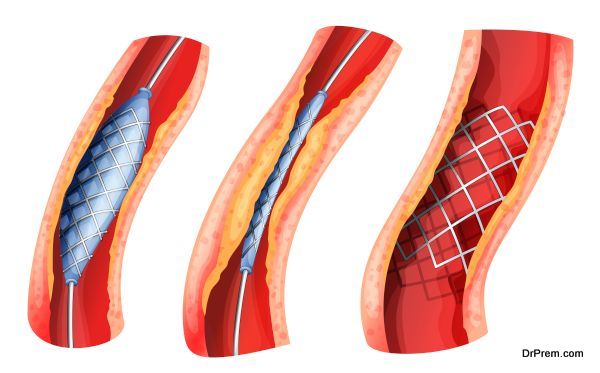Information
What is Angioplasty?
Angioplasty is a medical line of action to clear a narrowed down or completely blocked blood vessels (termed as coronary arteries) that transmit blood to the heart.
In angioplasty, a tiny metal mesh tube called stent, which expands inside the coronary artery is introduced. This object after eluting it with medicine is placed inside the arteries post angioplasty to prevent the arteries from closing up again.
Angioplasty has several names which are popular among medical circles like:
– Balloon angioplasty.
– Coronary angioplasty.
– Coronary artery angioplasty.
– Coronary artery balloon angioplasty.
– Cardiac angioplasty.
– PTCA (Percutaneous Tran luminal Coronary Angioplasty)
– Heart artery dilatation.
Deposits of cholesterol and unhealthy fats called plaque form a coating on the inner lining of the arteries. Consequently, the diameter of the inner hollow through which the supply of blood flows gets reduced giving rise to a condition known as atherosclerosis.
However, you need not go for angioplasty for every type of blockage. Some of them may be treated by bypass surgery as well.
Primarily, angioplasty is used to treat the following conditions:
-Constant chest pain known as angina which cannot be cured by administration of medicines.
-Blockage of one or more coronary arteries posing high risk of a heart attack.
-Blockage that develops during or after a heart attack.
Preparation and post procedure care:
Preparation:
Before angioplasty, the patient is required to go through a diagnostic test called angiography also known as cardiac catheterization. A catheter is inserted through the blood vessel leading to heart. A special contrast dye is applied which reveals that an x ray is applied to the coronary arteries. X ray images are studied for locating narrowed areas and assessing the risk factors.
The following tips are important prior to going through an angioplasty
-Stop eating and drinking anything after midnight, the day before the angioplasty is scheduled.
– Consult the doctor for taking regular medications in the morning of angioplasty.
Post operative care
Heavy pressure is applied to the place of incision by a medical attendant in the arm or the groin for about 20 minutes to stop bleeding if there is any.
-Sedatives are given to the patient to induce sleep.
-The attendant sees that the patient stays in bed for at least six hours post angioplasty.
Later a nurse will give all support and care to assist the patient get out of bed and walk around.
-Post angioplasty, the patient stays in the hospital overnight. If there is no bleeding or chest pain, the patient may head for home the following day.
-An escort should drive the patient back home.
-In some cases, a blood thinning drug is advised by the doctor to help prevent clots.
-A return visit to the doctor after six months is a must.
Abroad treatment cost
Angioplasty costs are not as high as you expect them to be. However, in the West, it is costlier than in Asian countries. Indian medical institutions like Manipal Heart Foundation, Bangalore and Indraprasth Apollo hospital, New Delhi have become specialists in the field of angioplasty. With the latest medical facilities and the team of qualified surgeons, India has turned into a coveted destination for a low cost angioplasty with high quality treatment. Let us take a look at a comparative expense on angioplasty in the US and the Asian counterparts. However, it is to be kept in mind quality is never compromised.
Country Expenses range
US (insurers cost) USD 25704 —USD 37128
US (retail cost) USD 57262—USD 82711
India USD 11000
Thailand USD 13000
Singapore USD 13000
In this context let us take a look at the European scenario. :
Country Treatment. Cost
Denmark. £ 4412
Italy £ 8489
The total Cost is commensurate with other factors too like the quality of accommodation and length and mode of travel.











